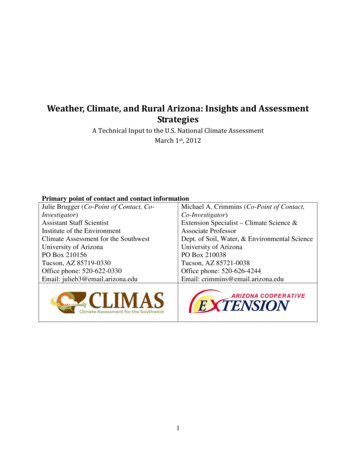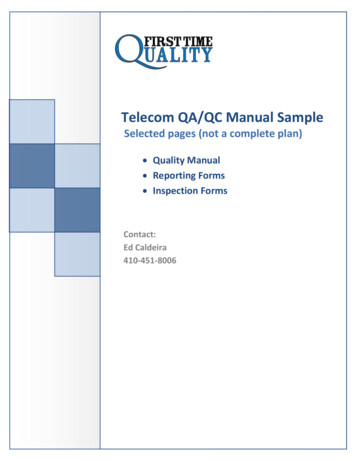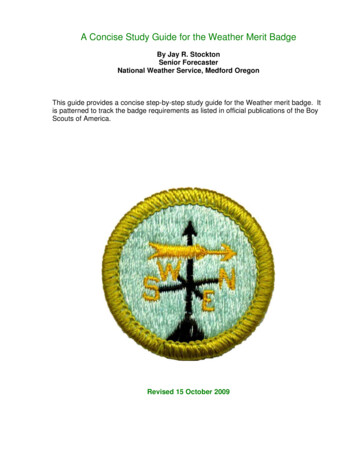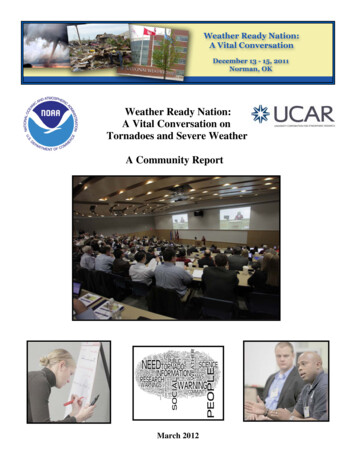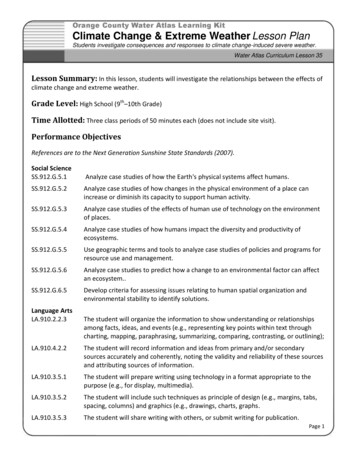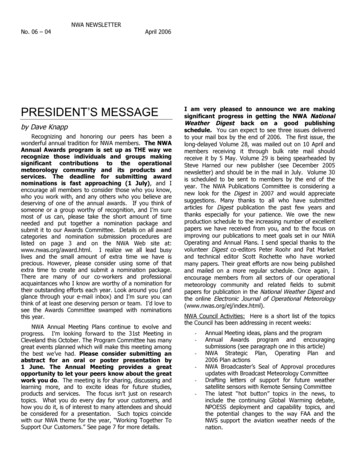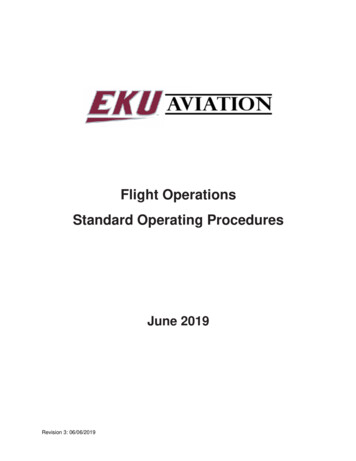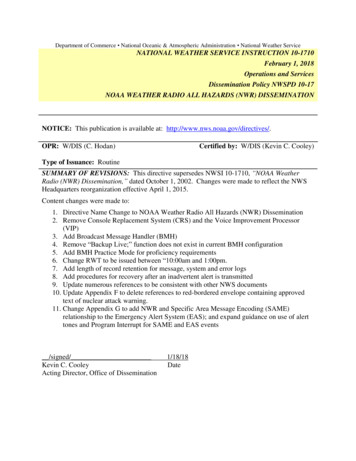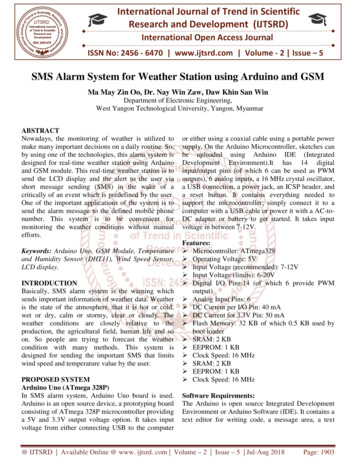
Transcription
WeatherMerit Badge WorkbookThis workbook can help you but you still need to read the merit badge pamphlet.This Workbook can help you organize your thoughts as you prepare to meet with your merit badge counselor.You still must satisfy your counselor that you can demonstrate each skill and have learned the information.You should use the work space provided for each requirement to keep track of which requirements have been completed,and to make notes for discussing the item with your counselor, not for providing full and complete answers.If a requirement says that you must take an action using words such as "discuss", "show","tell", "explain", "demonstrate", "identify", etc, that is what you must do.Merit Badge Counselors may not require the use of this or any similar workbooks.No one may add or subtract from the official requirements found in Scouts BSA Requirements (Pub. 33216 – SKU 653801).The requirements were last issued or revised in 2018 This workbook was updated in June 2020.Scout’s Name:Unit:Counselor’s Name: Phone No.: Email:http://www.USScouts.Org http://www.MeritBadge.OrgPlease submit errors, omissions, comments or suggestions about this workbook to: Workbooks@USScouts.OrgComments or suggestions for changes to the requirements for the merit badge should be sent to: Merit.Badge@Scouting.Org1. Define meteorology.Explain what weather is and what climate is.Weather:Climate:Workbook Copyright 2020 - U.S. Scouting Service Project, Inc. - All Rights ReservedRequirements Copyright, Boy Scouts of America (Used with permission.)This workbook may be reproduced and used locally by Scouts and Scouters for purposes consistent with the programs of theBoy Scouts of America (BSA), the World Organization of the Scout Movement (WOSM) or other Scouting and Guiding Organizations.However it may NOT be used or reproduced for electronic redistribution or for commercial or other non-Scoutingpurposes without the express permission of the U. S. Scouting Service Project, Inc. (USSSP).
WeatherScout's Name:Discuss how the weather affects farmers, sailors, aviators, and the outdoor construction industry.Farmers:Sailors:Aviators:Outdoor construction:Tell why weather forecasts are important to each of these groups.FarmersSailors:AviatorsOutdoor constructionWeather - Merit Badge WorkbookPage. 2 of 9
WeatherScout's Name:2. Name five dangerous weather-related conditions. Give the safety rules for each when outdoorsConditionSafety Rules1.2.3.4.5.and explain the difference between a severe weather watch and a warning.severe weather watchsevere weather warning Discuss the safety rules with your family.Weaand ether - Merit Badge WorkbookPage. 3 of 9
WeatherScout's Name:3. Explain the difference between high and low pressure systems in the atmosphere.Tell which is related to good and to poor weather.Draw cross sections of a cold front and a warm front showing the location and movements of the cold and warm air, thefrontal slope, the location and types of clouds associated with each type of front, and the location of precipitation.Cold FrontWeather - Merit Badge WorkbookWarm FontPage. 4 of 9
WeatherScout's Name:4. Tell what causes wind, why it rains, and how lightning and hail are formed.What causes wind:Why does it rain:How is lightning formed:How is hail formed:5. Identify and describe clouds in the low, middle, and upper levels of the atmosphere.Low:Middle:High:Weather - Merit Badge WorkbookPage. 5 of 9
WeatherScout's Name:Relate these to specific types of weather.6. Draw a diagram of the water cycle and label its major processes.Explain the water cycle to your counselor.Weather - Merit Badge WorkbookPage. 6 of 9
WeatherScout's Name:7. Identify some human activities that can alter the environment, and describe how they affect the climate and people.8. Describe how the tilt of Earth's axis helps determine the climate of a region near the equator, near the poles, and across thearea in between.Near the equatorNear the polesAcross the areain betweenWeather - Merit Badge WorkbookPage. 7 of 9
WeatherScout's Name:9. Do ONE of the following: a. Make one of the following instruments: wind vane, anemometer, rain gauge, or hygrometer.Keep a daily weather log for 1 week using information from this instrument as well as from other sources such aslocal radio and television stations, NOAA Weather Radio All Hazards, and Internet sources (with your parent'spermission). Record the following information at the same time every day: wind direction and speed, temperature,precipitation, and types of clouds. Be sure to make a note of any morning dew or frost. In the log, also list theweather forecasts from radio or television at the same time each day and show how the weather really turned out.Day 1Day 2Day 3Day 4Day 5Day 6Day 7TimeWind SpeedDirectionTemperaturePrecipitationCloud TypesDew or FrostForecastedActual b. Visit a National Weather Service office or talk with a local radio or television weathercaster, private meteorologist,local agricultural extension service officer, or university meteorology instructor.Date: Location: Person’s name:Find out what type of weather is most dangerous or damaging to your community.Determine how severe weather and flood warnings reach the homes in your community.Weather - Merit Badge WorkbookPage. 8 of 9
WeatherScout's Name:10. Give a talk of at least 5 minutes to a group (such as your unit or a Cub Scout pack) explaining the outdoor safety rules in the eventof lightning, flash floods, and tornadoes. Before your talk, share your outline with your counselor for approval.11. Find out about a weather-related career opportunity that interests you.Discuss with and explain to your counselor what training and education are required for such a position, and the responsibilitiesrequired of such a position.Training:Education:Responsibilities:When working on merit badges, Scouts and Scouters should be aware of some vital information in the current edition ofthe Guide to Advancement (BSA publication 33088). Important excerpts from that publication can be downloaded meritbadges.pdf.You can download a complete copy of the Guide to Advancement from ather - Merit Badge WorkbookPage. 9 of 9
Weather - Merit Badge Workbook Page. 7 of 9 7. Identify some human activities that can alter the environment, and describe how they affect the climate and people. 8. Describe how the tilt of Earth's axis helps determine the climate of a region near the equator, near the poles, and across the area in between. Near the equator Near the poles .
